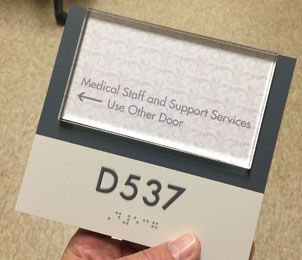If you avoid selling and installing ADA signage because you fear it’s overwhelmingly complicated, rigged with trap-setting rules, and too time-consuming to bother with, then let me paraphrase what former President Franklin D. Roosevelt said: “The only thing you have to fear is fear itself.”
The best way to deal with fear is to face it head on or seek help from professionals.
Facing Fears
Let’s start with facing your ADA fear head on.
You’ll find the regulations on the U.S. Department of Justice’s Web site (justice.gov). Invest your time to read them. It’s confidence building, and it will pay dividends later on. There you’ll find a list of resources and documents for Titles II and III of the Americans with Disabilities Act (ADA), revised in September 2010 and made mandatory nationwide effective March 15, 2012.
Title II relates to State and Government Facilities. Title III covers Public Accommodations and Commercial Facilities.
The rules for where ADA signs are required are covered in Chapter 2: Scoping Requirements, within Article 216 of the 2010 ADA Standards for Accessible Design. The rules for what is required for manufacturing and installation are in Chapter 7: Communications, Elements and Features, Article 703 of the 2010 Standards.
Most of it is self-explanatory, but if you can’t find an answer to your question or have trouble interpreting a piece you need, check out the information on ada.gov or call the ADA Information line at 800/514-0301 where you’ll find a patient, helpful person on the other end.
There are no foolish questions. They are there to help you get it right.
Seeking Help
On the other hand, you can turn to the professionals—the Web sites of wholesalers and suppliers or large-scale sign companies who have conveniently sorted out the rules and put them into laymen’s terms for their customers. They also list selected fonts they’ve tested against the requirements.

Then Do It
If you have the production capability, begin by making a few practice sets. Follow the rules for the basic layout of a functional, standard ADA sign and, once you have it down, move on from there to more design-oriented shapes.
Most ADA-specific font programs help to take care of the letter spacing requirements, as well as Grade 2 Braille translations. As long as you meet the criteria for the functional aspects, there are few limits to how attractive you can make the signs. The tests that work become your sales samples.
Some shops buy the basic sign from a supplier and then embellish it with custom-shaped background layers and client-specific graphics to fit a design scheme. You’ll also find insert signs that meet the requirements for raised letters and Braille on clear acrylic lenses backed by graphic paper inserts that you can produce.
Others rely on the professionals to manufacture the entire sign for them—meeting the client’s design specifications.
Regardless of who makes it, you have to understand the requirements of the particular job to be sure you deliver a sign program that meets the buyer’s design expectations and that will pass inspection when the owner goes for an occupancy permit. To do that, be sure to check not only the Federal but also local regulations.
A lot depends upon the type of project: corporate, health care, educational, retail, etc. Some institutions must follow additional regulations.
To meet the buyer’s expectations, you’ll want to know a few things.
For instance, is the sign program basic or are they looking for enhanced design details? What does their budget dictate? Is a designer already involved? Is wayfinding part of the program?
We suggest you keep it simple in the early stages, giving your clients a basic understanding of how to develop their sign program in conformity with the regulations and learning which elements are most important to the customer.
If you will be designing the signs, take your cues from architectural and design elements in the space itself or from the client’s brand identity.
If this is a moderate to large-scale project, a site survey is critical for you and the buyer. You’ll know what you’re getting into. You may discover challenges the buyer didn’t consider. And you’ll have a sound rationale for your proposal.
Once you’ve been selected, you can use your survey to set up the message schedule and location map for the project. Make sure you have complete sign-off from the designated decision maker at each stage of the process to avoid mistakes and costly overruns.
The regulations specify positioning for ADA signage. When you’re installing multiple signs in a given area, be consistent in placing them—i.e., in a hallway along which signs are posted at every door—so that they’re at the same height for uniformity within the specified space.
An unexpected challenge comes when a door opens out, toward the person reading the sign. If it’s too close to the door jam, there’s a possibility that someone exiting through that doorway could potentially hit the person reading the sign in the face with the door as they open it. We suggest avoiding close proximity to the door molding and centering the sign in the eighteen-inch field specified in the law.
If you find the rules too challenging, you can always turn to the professionals for more than guidelines on their Web sites. Many companies and suppliers will offer advice about a job, provide you with signs you can embellish, or manufacture the whole program for you so you can keep selling.
Conclusion
While the ADA regulations create fear in some, they also create consistency and order.
In the long run, they benefit more than the physically challenged for whom they’re intended by giving a focus to the project and encouraging safe access and egress for all. And they benefit the sign industry by creating a demand for product.
No matter which way you approach this, as a sign industry professional, it makes good sense to have a working knowledge of the ADA regulations. To paraphrase another popular quote, “Chance favors your prepared mind.”
Who knows what RFP will come across your desk next? Wouldn’t you hate to have a little fear that causes you to give up the job of a lifetime because you didn’t know the rules?
By Charles J. Kelly Jr., is president of Clarke Systems (clarkesystems.com), a manufacturer and distributor of ADA and wayfinding signage. You can email him at [email protected].
All photos: Clarke Systems











